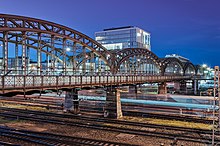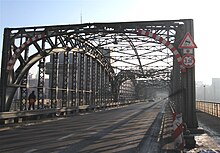Hacker Bridge


The Hackerbrücke is a road bridge in Munich . It runs over the tracks in the apron of Munich Central Station .
description
The arch bridge has six riveted arch girders with a span of 28.4 m, the arch height is almost eight meters.
location
The Hackerbrücke connects Landsberger Strasse in the Westend district to the south with Arnulfstrasse north of the Munich main station track apron and thus with the former Marsfeld in Maxvorstadt . The access road to both ends of the bridge is called Grasserstraße . The bridge itself is in the Ludwigsvorstadt district .
History and technology
The Hackerbrücke was built 1890-1894 by the Maschinenbau-Actien-Gesellschaft Nürnberg vorm. Klett & Co. was built by their subsidiary, the MAN plant in Gustavsburg , and is one of the few arched bridges preserved in Germany from the 19th century made of wrought iron , or welded iron , as it was called at the time. It was partially destroyed in World War II and reconstructed in 1953. A thorough renovation took place in 1983–1984, the construction was not changed. Similar to a Langerscher beam , the horizontal tensile forces occurring on the truss arches are absorbed by a tension band running at about head height . A concrete slab for the carriageway placed on cross girders is suspended from the truss arches that rest on the bridge piers. The roadway is 7 m wide; sidewalks are arranged outside the trusses.
The predecessor of today's bridge was the Herbststrasse Bridge, completed in 1870, with a simple iron framework construction a little east of today's Hackerbrücke. Previously there was a level crossing here.
The bridge got its name from the Hacker-Pschorr brewery, which was located at the southern end between the bridge and Bayerstraße until the end of the 1980s .
traffic
Up until the 1970s, the Hackerbrücke was of existential importance for private transport . It was one of the few really efficient connections close to the city center that alleviated the separation by the Munich Hbf track apron.
The construction of the Middle Ring , in particular the Donnersbergerbrücke and the defusing of Karlsplatz ( Stachus ) by opening the pedestrian zone, significantly reduced traffic pressure. Nevertheless, the Hackerbrücke is still an important north-south connection over the track apron.
Since 1972, which is at Hackerbrücke München Hackerbrücke station of the S-Bahn line built as the last above-ground station before the tunnel of the S-Bahn line. North (lines 16 and 17) and south (lines 18 and 19) of the Hackerbrücke you can change to the tram after a short walk. In addition, the central bus station in Munich (ZOB) for coach traffic is located on an area at the northern end of the Hackerbrücke .
During the Oktoberfest , the station plays an important role in transporting Oktoberfest visitors. The Hackerbrücke is then closed to car traffic in the evenings and on the weekends.
She can also be seen in the opening credits of the TV series SOKO 5113 .
literature
- Christine Rädlinger : History of the Munich bridges . Ed .: Construction Department of the City of Munich. Franz Schiermeier Verlag, Munich 2008, ISBN 978-3-9811425-2-5 (building bridges from the foundation of the city to today).
swell
- ↑ Friedrich Standfuß, Joachim Naumann: Bridges in Germany. Deutscher Bundes-Verlag, Cologne 2006, ISBN 978-3-935064-41-5
- ^ A bus station with the character of an airport ( Memento from March 6, 2016 in the Internet Archive ), Augsburger Allgemeine Zeitung from September 18, 2007
Web links
Coordinates: 48 ° 8 ′ 30 ″ N , 11 ° 32 ′ 54 ″ E




